Jinhao Jiang
R1-Searcher: Incentivizing the Search Capability in LLMs via Reinforcement Learning
Mar 07, 2025Abstract:Existing Large Reasoning Models (LRMs) have shown the potential of reinforcement learning (RL) to enhance the complex reasoning capabilities of Large Language Models~(LLMs). While they achieve remarkable performance on challenging tasks such as mathematics and coding, they often rely on their internal knowledge to solve problems, which can be inadequate for time-sensitive or knowledge-intensive questions, leading to inaccuracies and hallucinations. To address this, we propose \textbf{R1-Searcher}, a novel two-stage outcome-based RL approach designed to enhance the search capabilities of LLMs. This method allows LLMs to autonomously invoke external search systems to access additional knowledge during the reasoning process. Our framework relies exclusively on RL, without requiring process rewards or distillation for a cold start. % effectively generalizing to out-of-domain datasets and supporting both Base and Instruct models. Our experiments demonstrate that our method significantly outperforms previous strong RAG methods, even when compared to the closed-source GPT-4o-mini.
An Empirical Study on Eliciting and Improving R1-like Reasoning Models
Mar 06, 2025Abstract:In this report, we present the third technical report on the development of slow-thinking models as part of the STILL project. As the technical pathway becomes clearer, scaling RL training has become a central technique for implementing such reasoning models. We systematically experiment with and document the effects of various factors influencing RL training, conducting experiments on both base models and fine-tuned models. Specifically, we demonstrate that our RL training approach consistently improves the Qwen2.5-32B base models, enhancing both response length and test accuracy. Furthermore, we show that even when a model like DeepSeek-R1-Distill-Qwen-1.5B has already achieved a high performance level, it can be further refined through RL training, reaching an accuracy of 39.33% on AIME 2024. Beyond RL training, we also explore the use of tool manipulation, finding that it significantly boosts the reasoning performance of large reasoning models. This approach achieves a remarkable accuracy of 86.67% with greedy search on AIME 2024, underscoring its effectiveness in enhancing model capabilities. We release our resources at the STILL project website: https://github.com/RUCAIBox/Slow_Thinking_with_LLMs.
LongReD: Mitigating Short-Text Degradation of Long-Context Large Language Models via Restoration Distillation
Feb 11, 2025Abstract:Large language models (LLMs) have gained extended context windows through scaling positional encodings and lightweight continual pre-training. However, this often leads to degraded performance on short-text tasks, while the reasons for this degradation remain insufficiently explored. In this work, we identify two primary factors contributing to this issue: distribution drift in hidden states and attention scores, and catastrophic forgetting during continual pre-training. To address these challenges, we propose Long Context Pre-training with Restoration Distillation (LongReD), a novel approach designed to mitigate short-text performance degradation through minimizing the distribution discrepancy between the extended and original models. Besides training on long texts, LongReD distills the hidden state of selected layers from the original model on short texts. Additionally, LongReD also introduces a short-to-long distillation, aligning the output distribution on short texts with that on long texts by leveraging skipped positional indices. Experiments on common text benchmarks demonstrate that LongReD effectively preserves the model's short-text performance while maintaining comparable or even better capacity to handle long texts than baselines.
Holistically Guided Monte Carlo Tree Search for Intricate Information Seeking
Feb 07, 2025



Abstract:In the era of vast digital information, the sheer volume and heterogeneity of available information present significant challenges for intricate information seeking. Users frequently face multistep web search tasks that involve navigating vast and varied data sources. This complexity demands every step remains comprehensive, accurate, and relevant. However, traditional search methods often struggle to balance the need for localized precision with the broader context required for holistic understanding, leaving critical facets of intricate queries underexplored. In this paper, we introduce an LLM-based search assistant that adopts a new information seeking paradigm with holistically guided Monte Carlo tree search (HG-MCTS). We reformulate the task as a progressive information collection process with a knowledge memory and unite an adaptive checklist with multi-perspective reward modeling in MCTS. The adaptive checklist provides explicit sub-goals to guide the MCTS process toward comprehensive coverage of complex user queries. Simultaneously, our multi-perspective reward modeling offers both exploration and retrieval rewards, along with progress feedback that tracks completed and remaining sub-goals, refining the checklist as the tree search progresses. By striking a balance between localized tree expansion and global guidance, HG-MCTS reduces redundancy in search paths and ensures that all crucial aspects of an intricate query are properly addressed. Extensive experiments on real-world intricate information seeking tasks demonstrate that HG-MCTS acquires thorough knowledge collections and delivers more accurate final responses compared with existing baselines.
YuLan-Mini: An Open Data-efficient Language Model
Dec 24, 2024



Abstract:Effective pre-training of large language models (LLMs) has been challenging due to the immense resource demands and the complexity of the technical processes involved. This paper presents a detailed technical report on YuLan-Mini, a highly capable base model with 2.42B parameters that achieves top-tier performance among models of similar parameter scale. Our pre-training approach focuses on enhancing training efficacy through three key technical contributions: an elaborate data pipeline combines data cleaning with data schedule strategies, a robust optimization method to mitigate training instability, and an effective annealing approach that incorporates targeted data selection and long context training. Remarkably, YuLan-Mini, trained on 1.08T tokens, achieves performance comparable to industry-leading models that require significantly more data. To facilitate reproduction, we release the full details of the data composition for each training phase. Project details can be accessed at the following link: https://github.com/RUC-GSAI/YuLan-Mini.
RAG-Star: Enhancing Deliberative Reasoning with Retrieval Augmented Verification and Refinement
Dec 17, 2024



Abstract:Existing large language models (LLMs) show exceptional problem-solving capabilities but might struggle with complex reasoning tasks. Despite the successes of chain-of-thought and tree-based search methods, they mainly depend on the internal knowledge of LLMs to search over intermediate reasoning steps, limited to dealing with simple tasks involving fewer reasoning steps. In this paper, we propose \textbf{RAG-Star}, a novel RAG approach that integrates the retrieved information to guide the tree-based deliberative reasoning process that relies on the inherent knowledge of LLMs. By leveraging Monte Carlo Tree Search, RAG-Star iteratively plans intermediate sub-queries and answers for reasoning based on the LLM itself. To consolidate internal and external knowledge, we propose an retrieval-augmented verification that utilizes query- and answer-aware reward modeling to provide feedback for the inherent reasoning of LLMs. Our experiments involving Llama-3.1-8B-Instruct and GPT-4o demonstrate that RAG-Star significantly outperforms previous RAG and reasoning methods.
Imitate, Explore, and Self-Improve: A Reproduction Report on Slow-thinking Reasoning Systems
Dec 12, 2024


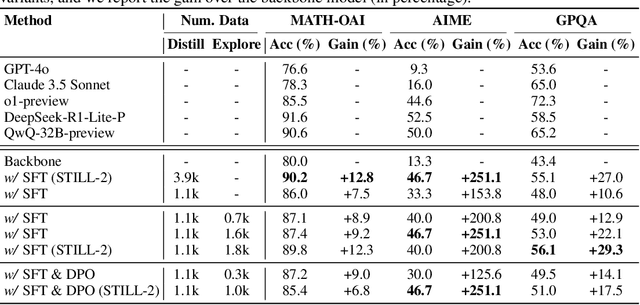
Abstract:Recently, slow-thinking reasoning systems, such as o1, have demonstrated remarkable capabilities in solving complex reasoning tasks. These systems typically engage in an extended thinking process before responding to a query, allowing them to generate more thorough, accurate, and well-reasoned solutions. These systems are primarily developed and maintained by industry, with their core techniques not publicly disclosed. In response, an increasing number of studies from the research community aim to explore the technical foundations underlying these powerful reasoning systems. Building on these prior efforts, this paper presents a reproduction report on implementing o1-like reasoning systems. We introduce an "imitate, explore, and self-improve" framework as our primary technical approach to train the reasoning model. In the initial phase, we use distilled long-form thought data to fine-tune the reasoning model, enabling it to invoke a slow-thinking mode. The model is then encouraged to explore challenging problems by generating multiple rollouts, which can result in increasingly more high-quality trajectories that lead to correct answers. Furthermore, the model undergoes self-improvement by iteratively refining its training dataset. To verify the effectiveness of this approach, we conduct extensive experiments on three challenging benchmarks. The experimental results demonstrate that our approach achieves competitive performance compared to industry-level reasoning systems on these benchmarks.
Technical Report: Enhancing LLM Reasoning with Reward-guided Tree Search
Nov 18, 2024



Abstract:Recently, test-time scaling has garnered significant attention from the research community, largely due to the substantial advancements of the o1 model released by OpenAI. By allocating more computational resources during the inference phase, large language models~(LLMs) can extensively explore the solution space by generating more thought tokens or diverse solutions, thereby producing more accurate responses. However, developing an o1-like reasoning approach is challenging, and researchers have been making various attempts to advance this open area of research. In this paper, we present a preliminary exploration into enhancing the reasoning abilities of LLMs through reward-guided tree search algorithms. This framework is implemented by integrating the policy model, reward model, and search algorithm. It is primarily constructed around a tree search algorithm, where the policy model navigates a dynamically expanding tree guided by a specially trained reward model. We thoroughly explore various design considerations necessary for implementing this framework and provide a detailed report of the technical aspects. To assess the effectiveness of our approach, we focus on mathematical reasoning tasks and conduct extensive evaluations on four challenging datasets, significantly enhancing the reasoning abilities of LLMs.
Towards Effective and Efficient Continual Pre-training of Large Language Models
Jul 26, 2024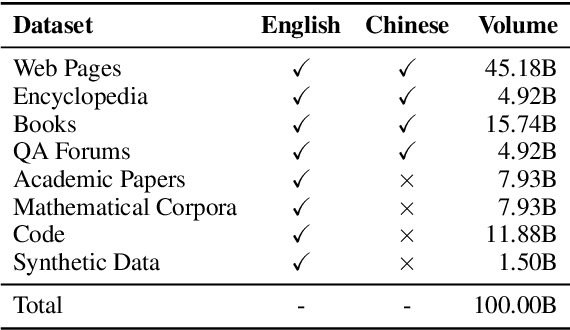
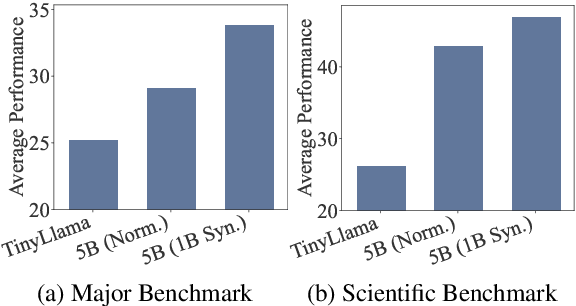
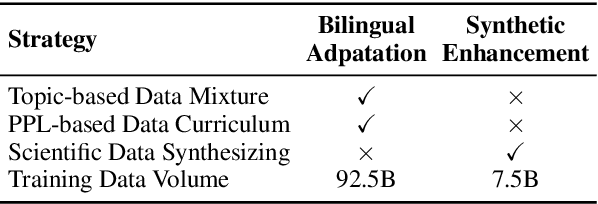
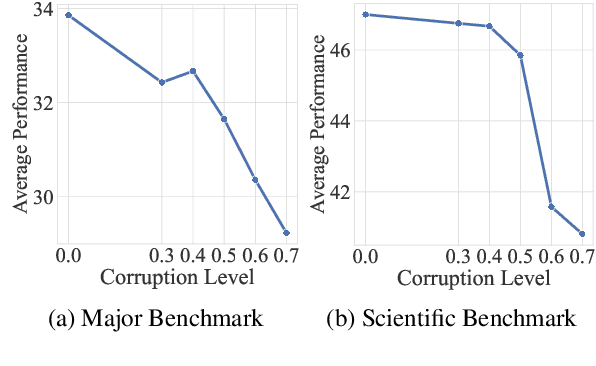
Abstract:Continual pre-training (CPT) has been an important approach for adapting language models to specific domains or tasks. To make the CPT approach more traceable, this paper presents a technical report for continually pre-training Llama-3 (8B), which significantly enhances the Chinese language ability and scientific reasoning ability of the backbone model. To enhance the new abilities while retaining the original abilities, we design specific data mixture and curriculum strategies by utilizing existing datasets and synthesizing high-quality datasets. Specifically, we synthesize multidisciplinary scientific question and answer (QA) pairs based on related web pages, and subsequently incorporate these synthetic data to improve the scientific reasoning ability of Llama-3. We refer to the model after CPT as Llama-3-SynE (Synthetic data Enhanced Llama-3). We also present the tuning experiments with a relatively small model -- TinyLlama, and employ the derived findings to train the backbone model. Extensive experiments on a number of evaluation benchmarks show that our approach can largely improve the performance of the backbone models, including both the general abilities (+8.81 on C-Eval and +6.31 on CMMLU) and the scientific reasoning abilities (+12.00 on MATH and +4.13 on SciEval), without hurting the original capacities. Our model, data, and codes are available at https://github.com/RUC-GSAI/Llama-3-SynE.
Mix-CPT: A Domain Adaptation Framework via Decoupling Knowledge Learning and Format Alignment
Jul 15, 2024Abstract:Adapting general large language models (LLMs) to specialized domains presents great challenges due to varied data distributions. This adaptation typically requires continual pre-training on massive domain-specific corpora to facilitate knowledge memorization, followed by training to apply this knowledge following human instructions and preferences. However, this method may result in inefficient knowledge memorization due to a lack of awareness of knowledge utilization and imposes substantial demands on LLMs to simultaneously learn knowledge utilization and format alignment with limited training samples. To facilitate the domain adaptation of LLM, we revise this process and propose a new domain adaptation framework including domain knowledge learning and general format alignment, called Mix-CPT. Specifically, we first conduct a knowledge mixture continual pre-training that concurrently focuses on knowledge memorization and utilization, allowing for mutual reinforcement. To avoid catastrophic forgetting during the continual pre-training process, we further incorporate a logit swap self-distillation constraint. Subsequently, leveraging the knowledge and capabilities acquired during continual pre-training, we efficiently perform instruction tuning and alignment with a few general training samples to achieve format alignment. Extensive experiments demonstrate that our proposed Mix-CPT framework can simultaneously improve the task-solving capabilities of LLMs on the target and general domains compared to the traditional adaptation methods.
 Add to Chrome
Add to Chrome Add to Firefox
Add to Firefox Add to Edge
Add to Edge